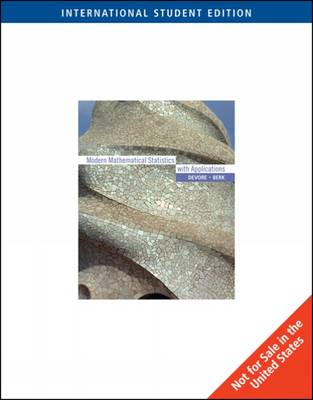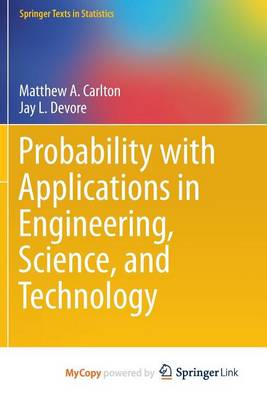Springer Texts in Statistics
2 total works
Modern Mathematical Statistics with Applications
by Kenneth Berk and Jay L DeVore
Published 2 February 2006
Many mathematical statistics texts are heavily oriented toward a rigorous mathematical development of probability and statistics, without emphasizing contemporary statistical practice. MODERN MATHEMATICAL STATISTICS WITH APPLICATIONS strikes a balance between mathematical foundations and statistical practice. Accomplished authors Jay Devore and Ken Berk first engage students with real-life problems and scenarios and then provide them with both foundational context and theory. This book follows the spirit of the Committee on the Undergraduate Program in Mathematics (CUPM) recommendation that every math student should study statistics and probability with an emphasis on data analysis.
Probability with Applications in Engineering, Science, and Technology
by Matthew a Carlton and Jay L DeVore
Published 3 September 2014
This book provides a contemporary and lively postcalculus introduction to the subject of probability. The exposition reflects a desirable balance between fundamental theory and many applications involving a broad range of real problem scenarios. It is intended to appeal to a wide audience, including mathematics and statistics majors, prospective engineers and scientists, and those business and social science majors interested in the quantitative aspects of their disciplines. A one-term course would cover material in the core chapters (1-4), hopefully supplemented by selections from one or more of the remaining chapters on statistical inference (Ch. 5), Markov chains (Ch. 6), stochastic processes (Ch. 7), and signal processing (Ch. 8). The last chapter is specifically designed for electrical and computer engineers, making the book suitable for a one-term class on random signals and noise. Alternatively, there is certainly enough material for those lucky enough to be teaching or taking a year-long course.
Most of the core will be accessible to those who have taken a year of univariate differential and integral calculus; matrix algebra, multivariate calculus, and engineering mathematics are needed for the later, more advanced chapters. One unique feature of this book is the inclusion of sections that illustrate the importance of software for carrying out simulations when answers to questions cannot be obtained analytically; R and Matlab code are provided so that students can create their own simulations. Another feature that sets this book apart is the Introduction, which addresses the question "Why study probability?" by surveying selected examples from recent journal articles and discussing some classic problems whose solutions run counter to intuition. The book contains about 1100 exercises, ranging from straightforward to reasonably challenging; roughly 700 of these appear in the first four chapters. The book's preface provides more information about our purpose, content, mathematical level, and suggestions for what can be covered in courses of varying duration.
Most of the core will be accessible to those who have taken a year of univariate differential and integral calculus; matrix algebra, multivariate calculus, and engineering mathematics are needed for the later, more advanced chapters. One unique feature of this book is the inclusion of sections that illustrate the importance of software for carrying out simulations when answers to questions cannot be obtained analytically; R and Matlab code are provided so that students can create their own simulations. Another feature that sets this book apart is the Introduction, which addresses the question "Why study probability?" by surveying selected examples from recent journal articles and discussing some classic problems whose solutions run counter to intuition. The book contains about 1100 exercises, ranging from straightforward to reasonably challenging; roughly 700 of these appear in the first four chapters. The book's preface provides more information about our purpose, content, mathematical level, and suggestions for what can be covered in courses of varying duration.

